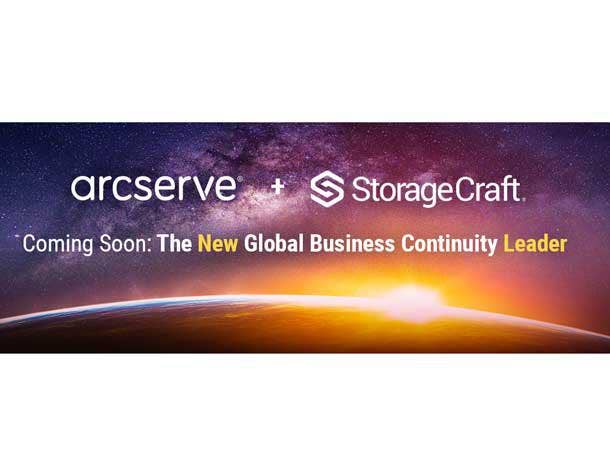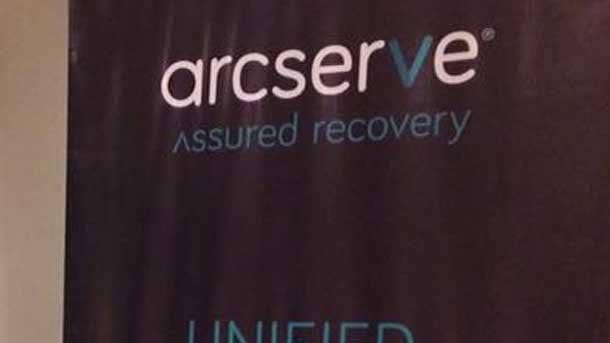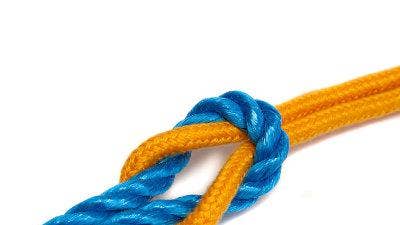Arcserve, StorageCraft Execs: A ‘Perfect Marriage’ Merger Will Unleash Recurring Revenue Opportunities For Partners
‘So we’re going to give our partners options, whether it’s perpetual licenses, subscriptions, soup du jour, whatever way they want to pivot. That’s part of our plan moving forward,’ says Arcserve CEO Tom Signorello who, along with StorageCraft President Douglas Brockett, talk with CRN exclusively about their plans for partners and more.

A Merger Designed With The Channel In Mind
Arcserve, a developer of enterprise and midrange data protection technology, and StorageCraft, a developer of MSP-focused data protection technology, said Wednesday that they had signed a definitive agreement to merge. The deal, for which financial terms were not disclosed, will combine the two under the Arcserve brand and create a top five data protection software giant.
Tom Signorello, CEO of Eden Prairie, Minn.-based Arcserve, and Douglas Brockett, president of Draper, Utah-based StorageCraft, told CRN in an exclusive interview that the two companies have very complementary technologies and channel and customer focuses, giving channel partners of both big opportunities to cross-sell each other’s products and even take on new business models.
Most importantly, both companies have always been 100 percent channel-focused and plan to stay that way, said Signorello, who formerly was CEO of Toronto-based solution provider and MSP OnX Enterprise Solutions.
“We’ll always be 100 percent channel-focused moving forward,” he told CRN. “We’re both diametrically opposed to any channel conflict. You won’t see us moving into a direct sales motion. We think there are opportunities for us to really double down with the channel and invest more in sales and marketing where both of us wouldn’t have had the ability to do that stand-alone. Coming together, you’re going to see us get very aggressive in the marketplace from a growth standpoint.”
Signorello and Brockett vowed that the merger would mean new opportunities for channel partners. Here’s what they had to say on those opportunities and more.

In a nutshell, what are Arcserve and StorageCraft doing?
Signorello: We signed a definitive agreement [in January] to merge both companies under the Arcserve banner. So Arcserve will be the parent company. And out of the gate, you’ll see ‘StorageCraft, an Arcserve company.’ That is the first phase from a branding perspective. But I think you can expect over the next two to four quarters a next level from the branding, whether it’s an all-new brand that will come out of this or one of our existing brands go away.
There will be integration across the entirety of both companies, across every function. So don’t let the ‘StorageCraft, an Arcserve company’ fool you from a stand-alone perspective. The real value we see out of both of these businesses coming together is the real complementary nature of our products, of our regions that we serve, and of our customer and partner bases. We at Arcserve are really strong in JAPAC [Japan and Asia-Pacific]. We have some pretty unique relationships there. We have very some strong and sizable business in EMEA. StorageCraft is predominantly, I think 80 percent, North America. Our North America business is probably 20 percent. And as you can imagine, with any integration there are synergies that come out of this. ... Our plan is to double down on marketing, presales and sales given the unique economies of scale that we’ll get bringing these businesses together. We’ll now be in the top five of data protection solution vendors globally. So it’s going to put us in a pretty unique spot with very little ‘dis-synergies’ from a market perspective, very little ‘dis-synergies’ from an end customer perspective. StorageCraft is largely focused on SMB, and Arcserve is focused on the midmarket and the enterprise space. So we’re super excited about this.

How about on the channel side?
Signorello: [We have an] opportunity to cross-sell into each other’s regions through each other’s partners that are different in a lot of ways. The heavily focused MSP business at StorageCraft [complements] our large traditional VAR and LAR [large account reseller] business. There’s just a ton of opportunities for the channel here. ...
Both of our companies culturally have always been 100 percent channel-focused. We’ll always be 100 percent channel-focused moving forward. We’re both diametrically opposed to any channel conflict. You won’t see us moving into a direct sales motion. We think there are opportunities for us to really double down with the channel and invest more in sales and marketing where both of us wouldn’t have had the ability to do that stand-alone. Coming together, you’re going to see us get very aggressive in the marketplace from a growth standpoint.

How much of the combined Arcserve-StorageCraft comes from recurring revenue opportunities for channel partners?
Signorello: I think it’s safe to say that, between the combined businesses, we’re north of 50 [percent] to 60 percent recurring revenue.
What we loved about the model that Doug put in place with the recurring revenue and the subscription methodology, we pushed hard over the past six months, and you’re starting to see us shift from what was purely a perpetual licensing play. We’ve just offered subscription licensing for our unified data protection product suite in the Americas last quarter. This quarter, we just expanded it globally. So we’re going to give our partners options, whether it’s perpetual licenses, subscriptions, soup du jour, whatever way they want to pivot. That’s part of our plan moving forward.
Did you just say Arcserve moved to do more with subscriptions because of the planned acquisition of StorageCraft?
Signorello: No. I think we did it is because the market wants it. The market wants to be able to buy subscription usage-based offerings. That’s first and foremost. But the great point about getting together with StorageCraft is the ecosystem that they built out from a back-office and front-office perspective that supports and drives that entire plan. You just can’t run into a subscription base. You need billing, you need an ERP system that will feed it. All of those pieces are in place. And that’s why it’s a perfect marriage for both companies to come together and then to leverage StorageCraft’s MSP community to push our products and offerings and to leverage our traditional partner base and alliance base globally to push StorageCraft products.

What about overlapping technologies between the two companies?
Brockett: It’s [all] about how you adapt the technology to the business spaces, and that’s where I think we get to the real complementary [advantage]. StorageCraft has really optimized our technology around our managed service provider channel and those solution providers who have a very service-oriented approach. And that ranges from how we run our web-based portals to allow them large degrees of multitenancy to the way we support usage-based billing to the way we allow for flexibility of installation and license migration. All of that stuff is an important part of the product that goes beyond what you think about as the core technology, and yet it’s the thing that makes it work from a business proposition perspective to the channel partners. ...
At the same time, Arcserve has done a lot around its products to make them suited for mid[market] to enterprise capabilities, and has certainly done extremely well with some of the international product requirements around data protection.
So there’s [not] a lot of overlap once you get beyond the basics of, ’Hey, how do you grab a snapshot?’ We think that one of the things we have to really look forward to is what we can get as solutions to problems that each of us see through our channel partners’ eyes without necessarily having any channel conflicts because we have such geographical diversity in what we’re bringing to the table.
So, it’s really a best-of-both-worlds situation and we don’t see a lot of redundancy in the technology as much as we see the use cases fitting together almost jigsaw-puzzle-like.

Are there any places where the merger could result in technology consolidation?
Signorello: From a product perspective, we don’t want to push our channel partners into anything that would cause friction for them. And that includes any forced technology transitions. Our intent is not to get out there and push as a first priority any converged capability. We obviously have some cool things we can do together from a technology road map perspective. The first of those is helping partners get to a common pane of glass.
We want to make sure all of our partners have the complete portfolios as they exist today available to them. Our first priority is making sure that channel partners who have installed bases and have business models built around our SKUs don’t have to do anything that would disrupt that business for them. We want to be the good partner in the sense of saying, ’What you’re doing today you can continue to do, and we’re going to create new opportunities for you going forward’

The data protection market today is very competitive with a lot of both pure-play vendors and others with data protection technology as part of their offerings in the mix. How do you see the competitive environment?
Signorello: Everything we do is around trying to decrease cost and complexity and increase the number of use cases. Some of our competitors may not have an appliance, may not have first-party DRaaS [Disaster Recovery as a Service]. Any time you need to bolt or ’Frankenstein’ these solutions together, it increases risk, increases cost and increases complexity for the customer. Everything we’re trying to do is the adverse of that. We’re trying to be a company that’s simple to do business with, that delivers eloquent solutions at a reasonable price that just work.
And unlike some of our competitors that are pulling back on the channel and pulling back on incentives now that they’ve gained what they believe is pretty significant market share and are now moving into direct sales motions that can cause channel conflict, we want to stay completely away from that. Given the scale of our combined entity now—like I said, we’ll be in the top five pure-play data protection providers--and given the synergies that will come out of this model, we can go really hard at the marketplace and incentivizing the channel, working alongside partners and increase our channel. You’re going to see us move pretty quickly as we’re integrating our portfolio.
It’s going to be pretty unique. And we’re expecting the market to gravitate to it, especially given some of the functionality that has come out lately on the Arcserve side of the house and will be coming out in the next couple weeks, and a lot of the cool stuff that Doug and his team have driven with their product suite over the past couple years.

Did Arcserve have to get new outside funding to make this merger happen?
Signorello: We’re a private company, so we’re not going to get into the exact structure of the funding associated with it. Just know that Marlin Equity [Partners, which in 2014 acquired Arcserve,] is still at the table, and [StorageCraft owner] TA Associates is still at the table. That’s a testament that both owners understand the value proposition here and are both committed to the success of the business moving forward.
The combination of Arcserve and StorageCraft is being officially termed a ’merger.’ But is it really Arcserve acquiring StorageCraft?
Signorello: Arcserve is the controlling entity here. StorageCraft will roll up under Arcserve. The first phase is ‘StorageCraft, an Arcserve Company’ from an integration perspective because we want to make sure that we don’t confuse the channel, that we give the channel time to acclimate to both businesses.

CRN: You mentioned competitors pulling back from the channel and creating more channel conflict. What’s an example of such a company?
Signorello: My mother taught me at an early age that it’s better not to bolster yourself up by picking apart your competitors. But there are a few large competitors that both Doug and I compete with that had a large European presence and are now pushing hard into North America. I’m sure you know who I’m referring to. And as they move up into the enterprise stack, that can lend itself to a direct selling motion and trying to gain market share from that perspective and buying business. Everything I see in deals that we’re in and from what I hear from our channel partners is that margins and rebates are being pulled back, and marketing dollars and MDF are being pulled back. They’re seeing channel conflict with larger deals, a couple large competitors going in and circumventing the channel.
[Arcserve and StorageCraft have grown by] just being focused on the channel and doing the right thing. ... Both Doug and I agree that we welcome proofs of concept with anyone in the marketplace. And when we do get proofs of concepts, head-to-heads, we win 70 [percent] to 80 percent of the time. Our issues have been economies of scale and really having enough marketing funds and sales funds to make a difference. And the great part about the efficiencies of this merger coming together is we now have those economies of scale.